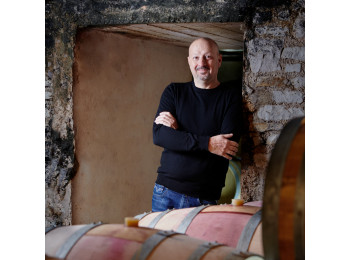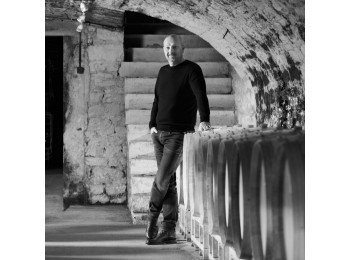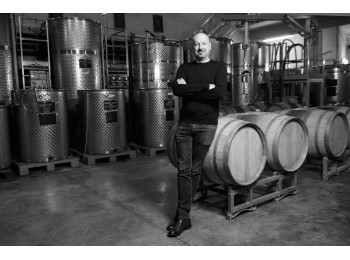Jean-Marie Fourrier took over the family’s 10 hectares property from his father in the mid 1990s at the age of 23 years old. His experience was gained not only at the family domaine in Gevrey-Chambertin, but whilst working at Domaine Drouhin in Oregon and with the legendary Henry Jayer in Vosne-Romanée. Jean-Marie was involved in the making of the classic 1988 vintage at Chez Jayer, and his winemaking philosophy has followed Jayer’s practices ever since: making great wines begin in the vineyard, and ever fastidious about maintaining healthy, well nurtured vines, followed by strict and extremely natural winemaking techniques. “The Philosophy of Doing Nothing”, that is Jean-Marie’s winemaking motto.
Assisted by his wife Vicki, the Domaine owns 10 hectares of vines spread across the commune of Gevrey-Chambertin with small plots of vines in other villages. The vast majority of the primary estate vineyard of Domaine Fourrier are planted with Pinot Noir grapes. Moreover, with the belief that old vines and vigilance in the vineyard and cellar make great wines of terroir, the grapes that make into Domaine Fourrier bottles come from vines over 30 years of age, hence the words “Vieilles Vignes” that are found on the labels. “Until a vineyard develops its root system, it doesn’t develop flavour”, says Jean-Marie.
His vineyard management is rigorous. With equilibrium being the keyword, he is in the vineyard at all times, and restricts his yields through pruning during the winter season as opposed to green harvesting, with no usage of any chemical fertilizer. Achieving natural balance between yield and vine growth as a function of each season’s growing conditions is Fourrier’s key objective. Fastidious about his grape selection, he instructs his pickers to eliminate any unsound grapes in the vineyard before the bunches go into the baskets as he wants to ensure that only perfect grapes go into the tank so as to yield the best lees for a successful elevage without racking.
To capture the individual, unique expression of terroir in his wines, Jean-Marie vinifies each vineyard separately, not only the premier and grand crus. In the cellar, the grapes are 100% destemmed with 3~4 days pre-maceration to gently draw out the aromatic phenols and colour. Jean-Marie avoids the use of sulphur dioxide. Rather he uses controlled temperature, lees contact and retaining carbon dioxide (a by-product of fermentation) to protect the wines. As such, residual carbon dioxide can be found in Fourrier’s wines, with breathing or decanting prior to serving always recommended. The use of new oak is less than 20%, whether this is for village or grand cru wines, with the idea to preserve the purity of fruit and personality of each wine and to keep renewing the barrel cellar. His catchphrase, “Oak is for slow breathing of the wine and not for taste”. The malolactic fermentation is allowed to proceed at its own rate. Jean-Marie believes that the longer the malolactic takes to finish, the greater the aging potential of the wine. He likes to leave the wines on the fine lees until bottling which usually occurs 18 to 20 months after harvest. Bottling is done without fining and filtration, with the dissolved carbon dioxide to remain in the wine as a protection rather than use sulphur dioxide in deference to “modern market requirements”.
All this results in wines with the inimitable Fourrier style – bright colours with pure red fruit on the nose, and the shape of the wine following the vineyard and its characteristics, reflecting such differences as slope, exposure and the amount of topsoil overlying the ancient limestone base. Superb poise, enchanting elegance and rich in complexity. That is Fourrier.
Jean-Marie Fourrier took over the family’s 10 hectares property from his father in the mid 1990s at the age of 23 years old. His experience was gained not only at the family domaine in Gevrey-Chambertin, but whilst working at Domaine Drouhin in Oregon and with the legendary Henry Jayer in Vosne-Romanée. Jean-Marie was involved in the making of the classic 1988 vintage at Chez Jayer, and his winemaking philosophy has followed Jayer’s practices ever since: making great wines begin in the vineyard, and ever fastidious about maintaining healthy, well nurtured vines, followed by strict and extremely natural winemaking techniques. “The Philosophy of Doing Nothing”, that is Jean-Marie’s winemaking motto.
Assisted by his wife Vicki, the Domaine owns 10 hectares of vines spread across the commune of Gevrey-Chambertin with small plots of vines in other villages. The vast majority of the primary estate vineyard of Domaine Fourrier are planted with Pinot Noir grapes. Moreover, with the belief that old vines and vigilance in the vineyard and cellar make great wines of terroir, the grapes that make into Domaine Fourrier bottles come from vines over 30 years of age, hence the words “Vieilles Vignes” that are found on the labels. “Until a vineyard develops its root system, it doesn’t develop flavour”, says Jean-Marie.
His vineyard management is rigorous. With equilibrium being the keyword, he is in the vineyard at all times, and restricts his yields through pruning during the winter season as opposed to green harvesting, with no usage of any chemical fertilizer. Achieving natural balance between yield and vine growth as a function of each season’s growing conditions is Fourrier’s key objective. Fastidious about his grape selection, he instructs his pickers to eliminate any unsound grapes in the vineyard before the bunches go into the baskets as he wants to ensure that only perfect grapes go into the tank so as to yield the best lees for a successful elevage without racking.
To capture the individual, unique expression of terroir in his wines, Jean-Marie vinifies each vineyard separately, not only the premier and grand crus. In the cellar, the grapes are 100% destemmed with 3~4 days pre-maceration to gently draw out the aromatic phenols and colour. Jean-Marie avoids the use of sulphur dioxide. Rather he uses controlled temperature, lees contact and retaining carbon dioxide (a by-product of fermentation) to protect the wines. As such, residual carbon dioxide can be found in Fourrier’s wines, with breathing or decanting prior to serving always recommended. The use of new oak is less than 20%, whether this is for village or grand cru wines, with the idea to preserve the purity of fruit and personality of each wine and to keep renewing the barrel cellar. His catchphrase, “Oak is for slow breathing of the wine and not for taste”. The malolactic fermentation is allowed to proceed at its own rate. Jean-Marie believes that the longer the malolactic takes to finish, the greater the aging potential of the wine. He likes to leave the wines on the fine lees until bottling which usually occurs 18 to 20 months after harvest. Bottling is done without fining and filtration, with the dissolved carbon dioxide to remain in the wine as a protection rather than use sulphur dioxide in deference to “modern market requirements”.
All this results in wines with the inimitable Fourrier style – bright colours with pure red fruit on the nose, and the shape of the wine following the vineyard and its characteristics, reflecting such differences as slope, exposure and the amount of topsoil overlying the ancient limestone base. Superb poise, enchanting elegance and rich in complexity. That is Fourrier.
Read more
Read less












